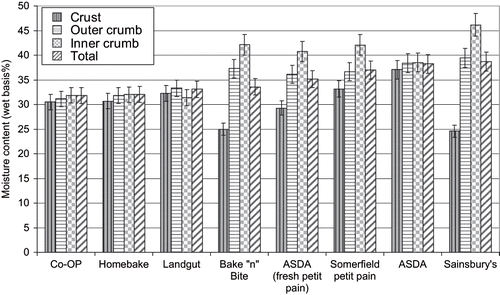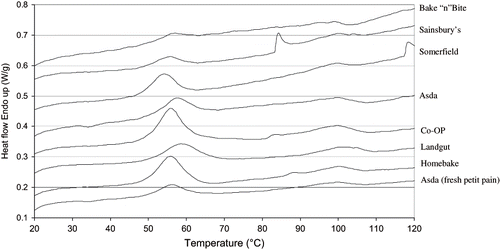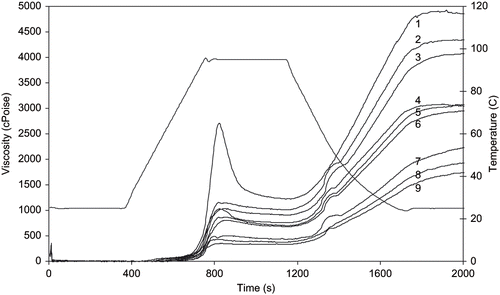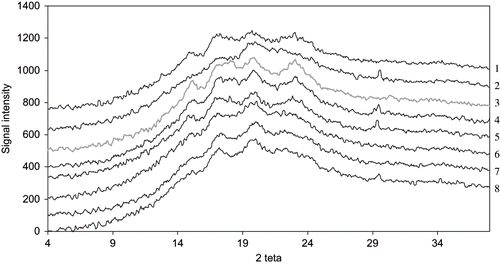Abstract
In this current study eight partially-baked breads were studied and compared in terms of a number of physicochemical characteristics: moisture distribution, density, RVA patterns, starch gelatinization, and retrogradation, amylose lipid complex formation and X-ray diffraction patterns. The samples were different in terms of total moisture content (from 32 to 38%) and moisture distribution in the cross section of the samples, starch retrogradation level (from 0.9 to 4.5 (J/g)) and RVA patterns. DSC experiments were carried out to determine the level of starch gelatinisation. The results showed that all starch granules in the eight partbaked breads were fully gelatinized under the conditions used and there was no intact starch granules left in the systems. Therefore, the second phase of baking will not be of great importance in terms of setting the structure and texture of the crumb of a product made from partbakaed bread. The role of the second phase of baking will be to a large extent the generation of flavor, crust, and coloration in the bread.
INTRODUCTION
The interrupted baking method used for bread was initially developed for improving the bread quality.[Citation1] However later the so called “interrupted process” was gradually used to produce a new generation of baked products. Partbaked breads were introduced to use central baking facilities to bake large quantities of low cost breads. Partially baked bread is an alternative product to freshly baked bread that is gaining market share every year because of its convenience; indeed, the end user needs only an oven to make the final baking of the product. The time needed for the preparation of bread from partbaked samples is about a few minutes which is 5–10% of the time of bread making if the process starts from scratch. Therefore, this product concerns domestic users as well as restaurants, retail display bakeries or shops. Partbaked bread is now becoming the leading product in terms of innovation and market share increase per year.[Citation2] Partbaked breads are being sold in forms of frozen and unfrozen products as required. For short shelf lives (up to a week) unfrozen partbaked bread is made, however for longer shelf lives (up to 6 months) partbaked frozen bread is made. Freezing the pre-baked bread is an easy way to prolong the shelf-life of the bread keeping its freshness.
Another advantage of frozen partbaked bread for supermarkets and restaurants is that it requires few types of equipments at the store and is faster to prepare, since it only needs to be removed from the freezer and put in the oven. Commercialization of frozen part-baked bread aims at reducing raw materials waste and production space and equipments at the commercialization store.[Citation3]
After mixing the ingredients and developing process the dough is then proved and partially baked. Partial baking consists of baking a bread at mild temperature and to stop baking just before or after a slight coloration of the crust. After cooling, the partbaked bread may go through chilling and freezing (if frozen partbaked is made) before being packed.[Citation4]
One of the major events happening during baking process of dough is gelatinisation of starch. With sufficient heating, the ordered structures inside starch granules can be disrupted. Depending on the amount of water, the disruption occurs at different ranges of temperature.[Citation5] In conditions of excess water (usually more than 65% water w.b.), water will help the process of disruption, which is called gelatinisation that occurs below 100°C. At low water contents (less than 30% water w.b.), the disruption of the granule can be considered as a pure melting of crystals. At intermediate moisture content (between 65 and 30–35 % water w.b.), water also assists the process but in a more heterogeneous way resulting in a disruption of granules occurring over a larger range of temperature. The two main events occurring during starch gelatinisation are the absorption of water by the starch granules and the irreversible loss of ordered structures.[Citation5,Citation6] The water uptake leads to a swelling of the starch granules.[Citation7,Citation8]
Leaching of amylose from the granule can follow the swelling process. [Citation9] Increasing of the production of partbaked breads will continue and it is expected to grow even more rapidly. Despite the importance of the market of partbaked breads and its large size still there are many problems affecting the final quality of partbaked breads compared to the fresh baked breads using the normal baking process. This to some extent could be due to the complexity of the systems, however the limited number of practical research projects performed so far on the subject is showing the need to do more fundamental research works.[Citation10]
Whenever the term “partbaked” is used it shows that the product would go through a final step of baking before being eaten. However in terms of the level of cooking of starch and its gelatinisation, it is not clear whether the starch is partially or fully baked in partbaked breads and how much intact starch granule is left in the system? The main aims of this current research were: 1) to investigate and quantify the level of cooked and intact starch; and 2) to study the extent of starch retrogradation and evaluate other physicochemical properties in a number of partbaked breads available in the UK retail market.
MATERIALS AND METHODS
To evaluate a wide range of partbaked breads, eight different partbaked samples (maximum number available) were bought form the local market in the UK: 1) Co-OP, 2) Homebake, 3) Landgut, 4) Bake “n” Bite, 5) ASDA (fresh petit pain), 6) Somerfiled petit pain, 7) ASDA, and 8) Sainsburry's. The samples were frozen at −20 C for further experiments.
Sample Sectioning
To map the water distribution across the width of each sample, a 15 cm central cut of each sample was used. The outer third (in weight) of each sample was peeled off using a sharp knife and called crust. The remaining parts were divided into two sections and were called outer and inner crumbs. This would give an opportunity to see any moisture difference in the cross section of each sample.
Determination of Moisture Content
The moisture content was determined gravimetrically using an oven drying method. The samples were dried in a 105°C oven. Each measurement was done in triplicate.
Density Measurement
The apparent density of the partbaked breads was measured using the rapeseeds displacement method. A container with a known volume and weight was used. Each bread was placed in the container and the empty void was filled with rapeseeds. Knowing the volume of the container, the density of rapeseed and the weight of bread, the density of partbaked bread was then calculated.
Color Measurement
Color measurements of the crust partbaked samples were carried out by using a Colorquest spectrophotometer SN C 5330 (Virginia, USA). Parameters of a, b, and L of the crust of each sample were measured by placing a small piece of each bread at the front of Hunter Lab opening. D65 light was used with an observer angle of 2°. Black, white and grey plates (supplied by the Colorquest spectrophotometer manufacturer) were used as standards.
Differential Scanning Calorimetry
Differential Scanning Calorimetry (DSC) was used to evaluate the physical transitions occurring in starch samples during heating. The heat gained or lost to go through a transition is found by measuring the differential heat flow, dH/dt (t, time) required to maintain a sample of the material and an inert reference at the same temperature during heating, at a specific heating rate. DSC in excess water (sample: water, 1: 2) was performed on freeze dried samples of the centre of each bread (inner crumb). About 5 mg of dry sample was placed in stainless steel pan and after addition of distilled water the pan was sealed and left on a roller overnight for moisture equilibrium across the sample. The pan was run in a DSC 7 (Perkin-Elmer, Beaconsfield, UK), calibrated with indium and cyclohexane standards. The pans were scanned at a heating rate of 10°C-min–1 from 25°C to 120°C. An empty pan was used as a reference. The transition can be characterized by the onset (To), peak (Top) and end (Te) temperature and the enthalpy change associated with the melting of amylopectin crystallites, calculated by integrating the area under the endothermic peak. If a sample with native starch granules is run an endothermic peak at about 55–75°C will appear while the retrogradation peaks would be seen at temperature range of 45–65°C, due to differences in the perfection level of crystalline amylopetcin. The amylase lipid complex would also appear at temperature range of 90–120 C.
X-ray Diffraction
The freeze dried powders of the inner crumb was equilibrated over a supersaturated salt solution of NaCl to get better X-ray traces. X-ray diffraction measurements have been performed in duplicate on a Sidemen's D5005 X-ray diffractometer. The X-ray generator was equipped with a copper tube operating at 40 kV and 30 mA and produced Cu K alpha radiations of approximately 1.54 Å wavelength. Data were recorded from 2θ = 4 to 38° using a step size of 0.02° and a residence time of 1s.[Citation11]
RVA Profile
The rapid visco analyser developed from the Brabender Amylograph was used to measure the rheological behaviour and related properties of starch.[Citation12] The standard temperature profile has been used for both raw and preconditioned materials. Determination of pasting temperature, peak viscosity, final viscosity and cold paste viscosity has been performed using the software provided with the RVA (TcW). Measurements were done in duplicates or triplicates.
RESULTS AND DISCUSSION
shows the total moisture content and moisture content of crust, outer and inner crumbs (each sample was divided into 3 sections as described in Sample Sectioning part). Total moisture of the partbaked samples varied from 32 to 38%. Co-OP and Sainsburry's samples showed the lowest and the highest moisture levels, respectively. Comparison of moisture content of crust, outer and inner crumbs of different samples reveals that the moisture distribution across the width of partbaked samples was not the same. In some samples (e.g., Co-OP) the moisture content of the three sections was almost the same and about 32%, however in some samples (e.g., Sainsburry's and Bake “n” Bite) there was a moisture gradient increase from crust to inner crumb (25% to about 45%). In the baking process just after the first bake, when partbaked breads come out of the oven they have the greatest moisture gradient from crust to the center. This is due to the fact that outer layers undergo a higher heat treatment than the inner layers. During the baking process when water migrates from the dough to the surrounding environment, for the inner parts water has to pass through the outer layers, therefore the resistance to mass transfer from the inner layer is much greater than the outer layers causing moisture gradient across the sample.
Figure 1 Total moisture content and moisture of each section (the samples were divided into 3 section in weight, crust, outer crumb, and inner crumb).

Data of density measurement using the seed displacement method presented in show that the density of partbaked samples available in the market could be very different. Out of the eight partbaked breads studied, Co-OP had the lowest density (0.18 g/ml) and Bake “n” Bite had the highest density (0.3 g/ml). This can affect the textural properties of the samples. The density values obtained in this study were similar to those reported by Barcenas and co-workers.[Citation13] Density can give rough ideas about the ratio of air bubbles to the bead matrix. In the lighter samples the air bubbles would be bigger and/or more in number. The density of baked samples is a good reflection of the quality of other stages such as proofing. If a well developed dough undergoes a proper proofing stage before and during baking it can keep more air bubbles with good size. During baking normally there is an increase in the volume of dough due to high temperature driving force (high pressure of water vapour inside the gas cells) that causes increase in bubble size volume. The structure of dough is set over the first phase of baking of a partbaked bread. This means that there will be no more considerable volume change during the second bake. To get more informative data on the level of starch cooking or gelatinisation, differential scanning calorimetry was carried out. DSC of freeze dried powders of the inner crumbs of each partbaked sample was run in excess water (as described in DSC section). Under these conditions if there was intact starch granules in the system, during heating of the sample in a DSC pan, for starch gelatinisation an endothermic peak would appear at the temperature range of 55–75°C. and clearly indicate that there was no endothermic peak at the mentioned temperature range. This confirms that at the end of the first bake for all eight partbaked breads there was no intact starch granules and almost all of the granules were gelatinized. In such a system during cooling the bread structure is set i.e. the gelatinized starch gels. Being completed the process of starch gelatinisation over the first bake of partbaked breads, the condition of first bake therefore determines the final volume of the partbaked breads and indeed the second bake won't be of great importance.
Table 1 Enthalpies of retrogradation (in the temperature range of 45–65°C) and amylase lipid complex (in the temperature range of 90–110°C)
Figure 3 Differential scanning calorimetry traces of partbaked samples. Heating rate 10 C/min. The peaks seen at the temperature ranges of 45–65 and 90–110°C are for starch retrogradation, and amylose lipid complex, respectively.

Table 2 RVA extracted values (peak viscosity and final viscosity) of freeze dried powders of the inner crumbs of partbaked samples against wheat flour
and indicate the presence of endothermic peaks and their enthalpies in the range of 45–65°C. These peaks are representative of starch retrogradation. Starch retrogradation seen on DSC peaks is believed to be due to amylopectin retrogradation.
Values of enthalpies were from 0.9 (J/g) for ASDA (fresh petit pain) to 4.5 (J/g) for Co-OP partbaked breads. These enthalpy values were lower than those reported by Barcenas and co-workers[Citation13] for parbaked breads stored at 4°C for 7 days. This difference could be due to temperature and time of storage of samples. The factors affecting the kinetic of retrogradation are water content of the system, temperature of storage and storage time after baking plus the presence and absence of antistaling agents.
Another endothermic peak can be seen on DSC traces at higher temperatures (90–110°C) in . The enthalpy values are presented in ranging from 0.69 to 1.35 J/g for Somerfield petit pain and Landgut, respectively. This endothermic peak is an indication of amylose lipid complex formation between the amylose fraction of starch and linear lipids present in the system. Although the enthalpy of this complex is low but there are a number of papers reporting on the importance of the issue on bread properties. The amount of amylose lipid complex is controlled by formulation (presence and absence of lipids and available amylose) and process conditions.[Citation15]
The RVA measures the viscosity of starch-water suspensions, which are stirred at uniform rate and heated to give a paste, held at any temperature for a specific time and then cooled at a uniform rate. The force required to drive the stirrer in the paste is recorded as a measure of the paste viscosity. The swelling of starch granules, during gelatinisation of native starch, leads to more contact between granules and less liquid phase. This results in the increase of the viscosity of the paste, beginning at the pasting temperature, until a maximum viscosity is reached at “the peak viscosity.” The “peak viscosity” is due to equilibrium between increase of viscosity because of more swelling of granules and decrease of viscosity as shear affects the integrity of granules. Peak viscosity indicates the water-binding capacity of the starch. Later during the cooling step, gelification takes place in the starch paste resulting in an increase of viscosity. The viscosity of the gel depends on the characteristics of the polymers present and is often used to define the particular quality of a sample. The viscosity at the end of the test is called “final viscosity.” In RVA scans of freeze dried powders of the inner crumbs of partbaked samples against wheat flour is indicating that there is a considerable difference between viscosity levels of the flour and the partbaked samples in terms of peak viscosity and final viscosity; the flour had greater values for both parameters compared to partbaked samples (e.g., peak viscosity of flour and Bake“n”Bite partbaked bread were 2676 and 868 cPoise, respectively). Low values of peak viscosity of processed samples are showing that starch granules have been gelatinised over baking process. This was in line with the information obtained from the DSC traces. Final viscosities of freeze dried powders of the eight partbaked breads varied from about 1500 to 4500 cPoise. This might be explained by the findings of Karaoglu[Citation14] that stated varying initial baking time can affect water activity and softness value of partbaked breads.
Figure 4 RVA scans of freeze dried powders of the inner crumbs of partbaked samples against wheat flour. From to top bottom: 1. Wheat flour, 2. Somefield petit pain, 3. Sainsburry's, 4. Homebake, 5. Co-OP, 6. Landgut, 7. Asda, 8. Asda (fresh petit pain), 9. Bake “n” Bite.

X-ray diffraction spectrums of freeze dried powders of different partbaked samples in show small wide peaks in particular from 2θ of 14 to 24. This indicates that the powders under study were to some extent retrograded, this is in line with the DSC and RVA data.
CONCLUSION
Some main physicochemical properties of eight partbaked breads bought from the UK market were studied and compared. The samples were different in terms of total moisture content and moisture distribution in the cross section of the samples. This could be due to differences in terms of process conditions, water content of dough and storage conditions after being partially baked. DSC experiments carried out to determine the level of starch gelatinization showed that all starch granules in the eight partbaked breads were fully gelatinized under the conditions used for partially baking of breads and there was no intact starch granules left in the systems, which was confirmed by the RVA results. Therefore the second phase of baking will not be of great importance in terms of setting the structure and texture of the crumb of the final product made from a partbaked bread. The role of the second bake will be mainly the generation of flavor, crust and coloration in the bread. Different final viscosities obtained for freeze dried powders of partbaked breads indicate that hydration and water absorption of the powders analysed were different. This could affect sensory attributes of the partbaked breads on consumption. The DSC data also confirmed that the partbaked breads were all partially retrograded.
Hydration changes could be attributed to process conditions before and during baking, while differences in retrogradation enthalpies of the partbaked breads could be due to storage time and storage conditions after baking.
ACKNOWLEDGMENTS
Some parts of the experiments presented in this paper were carried out in the Food Sciences Division of Nottingham University (Nottingham, UK). Technical and instrumental supports received are greatly acknowledged.
REFERENCES
- Labutina , N.V. , Puchkova , L.I. , Gubiev , Y.K. , Ilyasov , S.G. and Kats , A.M. 1981 . Effect of Dough Moisture Content on the Quality of Bread Products . Khlebopekarnaya Konditerskaya Promyshlennost , 8 : 27 – 28 .
- Girafood Web site/report on refrigeration in bread making in Europe. 2003 http://www.girafood.com (Accessed: 30 June 2007 ).
- Carr , L.G. and Tadini , C.C. 2003 . Influence of Yeast and Vegetable Shortening on Physical and Textural Parameters of Frozen Part Baked French Bread . Lebensm.-Wiss. u.-Technol. , 36 : 609 – 614 .
- Bail , A. , Le , J.Y. , Monteau , F. , Margerie , T. , Lucas , A.C. and Reverdy , Y. 2005 . Impact of Selected Process Parameters on Crust Flaking of Frozen Partly Baked Bread . Journal of Food Engineering , 69 ( 4 ) : 503 – 509 .
- Donovan , J.W. 1979 . Phase Transition of the Starch-water System . Biopolymers , 18 : 263 – 275 .
- Jenkins , P.J. and Donald , A.M. 1998 . Gelatinisation of Starch: A Combined SAXS/WAXS/DSC and SANS Study . Carbohydrate Research , 308 ( 1–2 ) : 133 – 147 .
- Ghiasi , K. , Hoseney , R.C. and Varrianomarston , E. 1982 . Gelatinization of Wheat-starch .1. Excess-water Systems . Cereal Chemistry , 59 ( 2 ) : 81 – 85 .
- Ghiasi , K. , Hoseney , R.C. and Varrianomarston , E. 1982 . Gelatinization of Wheat-starch. 3. Comparison by Differential Scanning Calorimetry and Light-microscopy . Cereal Chemistry , 59 ( 4 ) : 258 – 262 .
- Leach , H.W. , McCowen , L.D. and Schoch , T.J. 1959 . Structure of the Starch Granule. I. Swelling and Solubility Patterns of Various Starches . Cereal Chemistry , 36 : 534 – 544 .
- Bárcenas , M.E. , Benedito , C. and Rosell , C.M. 2004 . Use of Hydrocolloids as Bread Improvers in Interrupted Baking Process with Frozen Storage . Food Hydrocolloids , 18 ( 5 ) : 769 – 774 .
- Bruker AXS www.bruker.co.uk (Accessed: 30 June 2007 ).
- Newport Scientific. www.newport.com.au (Accessed: 30 June 2007 ).
- Barcenas , M.E. , Haros , M. , Bendito , C. and Rosell , C.M. 2003 . Effect of Freezing and Frozen Storage on the Staling of Partbaked Bread . Food Research International , 36 : 863 – 869 .
- Karaoglu , M.M. 2006 . Effect of Initial Baking and Storage Time on Pasting Properties and Aging of Par-baked and Rebaked Rye Bread . International Journal of Food Properties , 9 ( 3 ) : 583 – 596 .
- Stephan , H. 1977 . Influence of Pre-baking on Bread Quality . Getreide Mehl und Brot , 31 : 100 – 102 .

